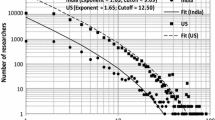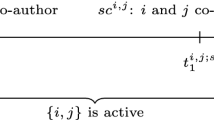Abstract
Empirical studies such as Goyal et al. (J Polit Econ 114(2):403–412, 2006) or Newman (Proc Natl Acad Sci USA 101(Suppl. 1):5200–5205, 2004) show that scientific collaboration networks present a highly unequal and hierarchical distribution of links. This implies that some researchers can be much more active and productive than others and, consequently, they can enjoy a much better scientific reputation. One may think that big intrinsical differences among researchers can constitute the main driving force behind these inequalities. Nevertheless, this model shows that, under specific circumstances, very similar individuals may self-organize themselves forming unequal and hierarchical structures.
Similar content being viewed by others
References
Albert R., Barabási A. L. (1999) Emergence of scaling in random networks. Science 286(5439): 509–512
Albert R., Barabási A. L. (2002) Statistical mechanics of complex networks. American Physical Society 74(1): 47–97
Arenas, A., Cabrales, A., Danon, L., Díaz-Aguilera, A., Guimerà, R., & Vega-Redondo, F. (2003). Optimal information transmission in organizations: Search and congestion. Working paper Universitat Pompeu Fabra, 698.
Bala V., Goyal S. (2000) A noncooperative model of network formation. Econometrical 68(5): 1181–1219
Barabási A. L., Jeong H., Néda Z., Ravasz E., Schubert A., Vicsek T. (2002) Evolution of the social network of scientific collaborations. Physica A 311: 590–614
Borgatti, S. P. (2005). Facilitating knowledge flows. http://www.socialnetworkanalysis.com/knowledge_sharing.htm. Accessed June 2011.
Borgatti S. P., Everett M. G. (1999) Models of core/periphery structures. Social Networks 21: 375–395
Calvó-Armengol A., Jackson M. O. (2004) The effects of social networks on employment and inequality. American Economic Review 94(3): 426–454
Cooper C., Frieze A. (2003) A general model of web graphs. Random Structures and Algorithms 22(3): 311–335
Cross R., Parker A., Prusak L., Borgatti S. P. (2001) Knowing What We Know: Supporting knowledge creation and sharing in social networks. Organizational Dynamics 30(2): 110–120
Ellison G. (2002) Evolving standards for academic publishing: A q-r theory. Journal of Political Economy 110(5): 994–1034
Goyal S., van der Leij M., Moraga-González J. L. (2006) Economics: An emerging small world. Journal of Political Economy 114(2): 403–412
Goyal S., Vega-Redondo F. (2007) Structural holes in social networks. Journal of Economic Theory 137: 460–492
Hudson J. (1996) Trends in multi-authored papers in Economics. Journal of Economic Perspectives 10(3): 153–158
Jackson M. O., Wolinsky A. (1996) A strategic model of economic and social networks. Journal of Economic Theory 71(1): 44–74
Jackson, M. O. (2004). A survey of models of network formation: Stability and efficiency. In Group formation in economics: Networks, clubs and coalitions. Cambridge: Cambridge Universtity Press.
Jackson M. O., Rogers B. W. (2007) Meeting strangers and friends of friends: How random are social networks?. American Economic Review 97(3): 890–915
Kranton R. E., Minehart D. (2001) A theory of buyer–seller networks. American Economic Revview 91(3): 485–508
Laband D. N., Tollison R. D. (2000) Intelectual collaboration. Journal of Political Economy 108(3): 632–662
McBride M. (2006) Imperfect monitoring in communication networks. Journal of Economic Theory 126: 97–119
Milgram S. (1967) The small world problem. Psycology Today 2: 60–67
Mullins N. C., Hargens L. L., Hecht P. K., Kick E. L. (1977) The group structure of cocitation clusters: A comparative study. American Sociological Review 42(4): 552–562
Newman M.E.J. (2001a) Scientific collaboration networks I: Network construction and fundamental results. Physical Review E 64: 016131
Newman M.E.J. (2001b) Scientific collaboration networks II: Shortest paths, weighted networks, and centrality. Physical Review E 64: 016132
Newman M. E. J. (2003) The structure and function of complex networks. SIAM Review 45(2): 167–256
Newman M. E. J. (2004) Co-authorship networks and patterns of scientific collaboration. Proceedings of the National Academy of Sciences of United States of America 101(Suppl. 1): 5200–5205
Price D. J. d. S. (1976) A general theory of bibliometric and other cumulative advantage processes. Journal of the American Society for Information Science 27: 292–306
Van der Leij, M. (2006). The Economics of Networks: Theory and Empirics. Ph.D. thesis, Tinbergen Institute, Erasmus University, Rotterdam.
Watts D. (1999) Small worlds. Princeton Universtity Press, Princeton
Author information
Authors and Affiliations
Corresponding author
Rights and permissions
About this article
Cite this article
Rubí-Barceló, A. Core/periphery scientific collaboration networks among very similar researchers. Theory Decis 72, 463–483 (2012). https://doi.org/10.1007/s11238-011-9252-9
Published:
Issue Date:
DOI: https://doi.org/10.1007/s11238-011-9252-9




